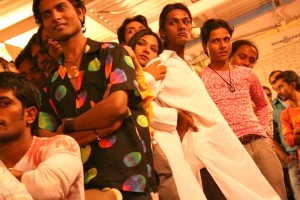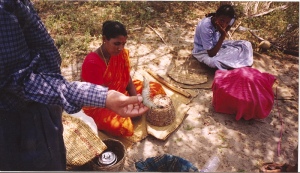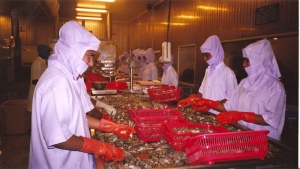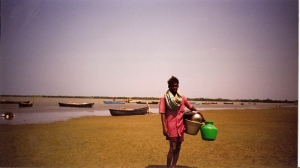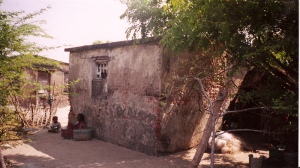By Malcolm Gay (class of 2003)
HYDERABAD, Andhra Pradesh, March 2003 – With a tenant list boasting the likes of Microsoft, Oracle and Infosys, Cyber Towers, a 580,000 sq. foot building, would feel right at home along California’s Route 101. But the Internet-connected building, with a soaring atrium, central fountain and constant, air-conditioned breeze, has come to symbolize this southern Indian state’s bid to lure private investment, generate wealth and kick-start development. It’s the crown jewel of a series of policies that has kept the state’s charismatic leader, Chandrababu Naidu, in office since 1995 as a popular figure in Third World development circles.
But unlike its northern Californian cousins, Cyber Towers lies a mere 60 kilometers away from villages like Thangadapalli, a rural hamlet of 8,000 where scant electricity, a two-year drought and few employment opportunities force many villagers to spend much of the year migrating in search of work.
Hunger is this village’s constant companion, as is disease and poverty. Roads go unpaved, sewers remain open and many of the villagers’ low-slung homes have neither indoor plumbing nor electricity. What little power the village receives — five hours per day, according to villagers — is inadequate for residents’ irrigation pumps, and their fields are left barren.
It is the tightrope between these two worlds — the lure of high-tech and the recalcitrant problems of poverty — that Naidu’s government must successfully walk in its bid to win a third successive term in elections scheduled for next year. It’s an election that is being closely monitored by the rest of India: Its outcome is important not only for Naidu’s future, but it’s also being seen as a litmus test for a new model of development in the subcontinent.
In a state where over half of the 77 million residents earn less than $500 a year, villages like Thangadapalli are not the exception, they are the rule. Only three out of 10 residents in the state have access to piped water; the overall literacy rate is just over 50 percent; and almost a quarter live below the poverty line, pegged at $49 per year.
Yet Naidu has turned Hyderabad into one of the country’s hottest destinations for software services and information technology (IT). His government is the first in India to commit itself to economic growth using IT services. But can Naidu’s strategy, using IT to spur growth, translate into social and economic goods for the majority of the people of his state? Or will it simply deepen the existing divide? The answer is far from clear.
What is clear is that Naidu and his supporters have faith in his vision of development. His regimen of corporate power subsidies, land grants and relaxed tax laws has delivered Andhra Pradesh much-needed investment. The state received $350 million in World Bank funds for beefing-up its computer and road infrastructure — the first such loan to go to an Indian state. He’s outfitted the state’s capital, Hyderabad, with slick flyovers, well-lit streets and a host of five-star hotels. He has also quadrupled the number of trees in the city, and his efforts have earned him audiences with Bill Gates and Bill Clinton. The effects of his policies have also been felt abroad. Not only is Naidu fast becoming a fixture at the World Economic Forum in Davos, Switzerland, but one in four Indian workers in Silicon Valley comes from Andhra Pradesh.
Naidu has set the ambitious goal of a 9 to 10 percent annual growth rate for the state economy. The state’s present growth rate is just under 7 percent as compared to the national figure of 5.2 percent. In Andhra Pradesh 2020, a policy paper on state development over the next two decades, the government also promises to increase the services sector — of which IT is the key component — nearly 16-fold.
To that end, Naidu has expanded the state’s university system. He established the Indian Institute of Internet Technology that links the Indian School of Business to prominent American business schools, and increased the number of available engineering slots from 8,000 in 1995 to more than 47,000 in 2002. He’s also taken steps to make the state attractive to foreign investment. Hi-Tec City (Hyderabad Information Technology Engineering Consultancy City), the office park that houses Cyber Towers, sits on 151 acres of land donated by the state.
Developers promise that the park will eventually offer more than 5 million sq. feet of office space, as well as corporate housing, malls and discos. The park already has three generator stations, insuring that in a country where electricity is a scarce commodity, the energy-hungry tech companies will never suffer a blackout. Foreign companies are also offered a 25 percent electricity subsidy and are exempt from many of the regulations that tie up other industries.
Still, much remains to be done. Critics charge that, due to a diet of tax breaks and subsidies, the $55 million tech industry contributes too little to the state’s overall economy. Currently, high-tech accounts for less than one percent of the state’s GDP, and while tech jobs may be lucrative, less than 69,000 people work in the sector. They charge that Naidu is too urban, elitist and “obsessed” with technology, deriding him as a “laptop” chief minister.
“My question is, when you repeatedly say at international forums that the world is looking to Andhra Pradesh for investment — but what about the ground reality,” said K. Rosaiah, a local leader of the out-of-power Congress Party. “What [the people] require, what they demand, is better infrastructure, better roads, pure drinking water and supply of electricity.…This government is forgetting the basic amenities and the demands of the people and is always talking about IT.”
In an attempt to ease village life, the government has embarked on a series of e-governance projects. The programs allow Indians — who must often trudge from office to office to pay their bills — to pay all of their bills at one localized service center. Initially launched in the capital, “e-seva” is being expanded to nearly 230 locations throughout the state.
“I think we should not minimize [Naidu’s] achievements in streamlining government,” said Pranab Bardhan, professor of economics at the University of California, Berkeley. “Andhra has done quite well in computerizing land records which in most of other states is in a big mess. [But] he needs to do much more. He needs to expand his policy range, and that’s where IT is not enough. I’m not sure that the life of the poor in Andhra Pradesh has been significantly improved.”
One reason is that high-tech has done little to clean up the state’s fiscal mess. “Naidu’s undoubtedly paying a lot of attention to the development of the state,” said Kodanda Ram, an associate professor of Political Science at Osmania University in Hyderabad. “[But] the farmers, the artisans, the tribals — to develop these sectors a lot of funds need to be invested, and that’s something that Naidu has not done. They are losing their livelihood.”
And the state’s public debt is increasing. Under Naidu, the public debt has grown from under $3 billion in 1995-96, to more than $9.5 billion in 2003-04. During those same years, the state’s outstanding loans from the central government have swollen from just over $2.1 billion to over $4.5 billion.
Still, in a country where politicians traditionally speak the language of government charity and subsidy, Naidu has dramatically cut the residential electricity subsidy, raising rates by as much as 70 percent. He has privatized four key state-owned companies and has plans for 10 more. Voluntary Retirement Schemes, meant to trim down the bloated bureaucracy — its salaries bleed away a majority of the state’s revenue — have been introduced and the government says it’s amending labor laws to make hiring and firing easier.
But all this is at best a long, long haul, and people are getting increasingly impatient. Poverty remains the state’s biggest problem. On average, 400 farmers annually commit suicide in Andhra Pradesh — by far the highest rate in the country.
The state also leads the country in doling out ration cards, a key poverty indicator. And while Naidu may talk of reforms, under his leadership state spending on non-development disbursements has grown to over 40 percent of all government spending.
“On the one side, he says he wants to use development as the main arm to mobilize political involvement [of the villagers], but it’s primarily patronage that he’s using to motivate them,” said Ram. “If you go to the villages and ask them they laugh and laugh. They say the same road has been repaired again and again; the same water tank has been repaired again and again.”
But during a visit to Thangadapalli, few people were laughing. Though their main road was paved, villagers complained that they received only five hours of electricity per day, an insufficient amount to irrigate their lands. “[The government] has only concentrated on city development, but it’s neglecting the smaller villages,” said Uppudu Usaiah, 58, a small, wizened woman wearing a green sari.
Usaiah was accompanied by her son, Sarjeeva, whose legs have been left withered and crippled from excess fluoride in the village’s water supply. Gesturing toward a rusted spigot, Usaiah said through an interpreter: “I’ve had no other option but to drink this water.”
Confronted with these villagers’ plight, Special Secretary to the Chief Minister Naidu Randeep Sudan is quick to defend his boss. “If you look at the effect of the fluoride — this is something that has happened over a period of years,” he said, adding that under Naidu the government has started a project to add over 10,000 kilometers of roads to the state. “If you compare the situation today to what it was five years ago, there’s been a dramatic change.”
But some remain unimpressed. “I’m not concerned with computers,” said Suruvi Venkateram, 39, a villager who arrived on a hand-powered bicycle, his small body twisted and made useless from excess fluoride. “We’re more worried about immediate things, like drinking water, employment and irrigation.”
 DELHI, India, July 19, 2012—In India, cricket is the national obsession, but it is actually field hockey that is its official game, with a more deeply embedded history within this patchwork of nations. Field hockey is the country’s most decorated international sport, and the men’s national team is the most accomplished in the Olympic event’s history—winners of 11 medals, including eight gold, dating back to 1928.
DELHI, India, July 19, 2012—In India, cricket is the national obsession, but it is actually field hockey that is its official game, with a more deeply embedded history within this patchwork of nations. Field hockey is the country’s most decorated international sport, and the men’s national team is the most accomplished in the Olympic event’s history—winners of 11 medals, including eight gold, dating back to 1928.



